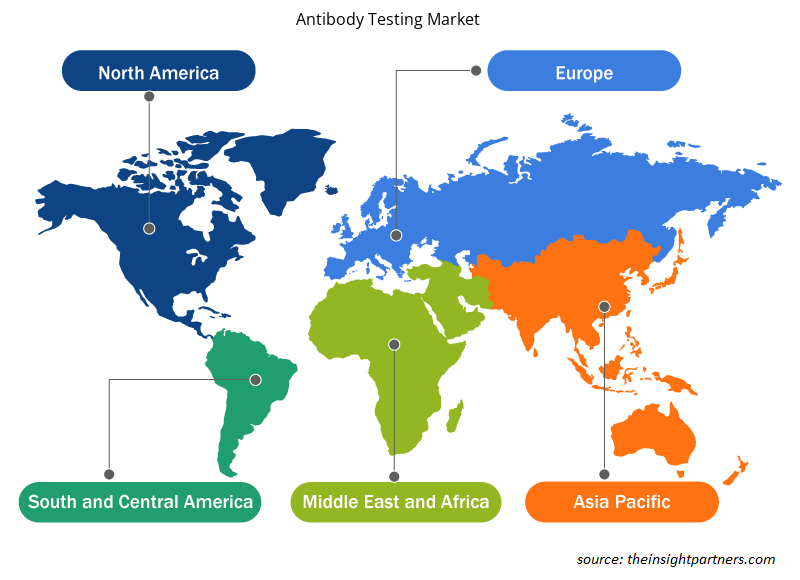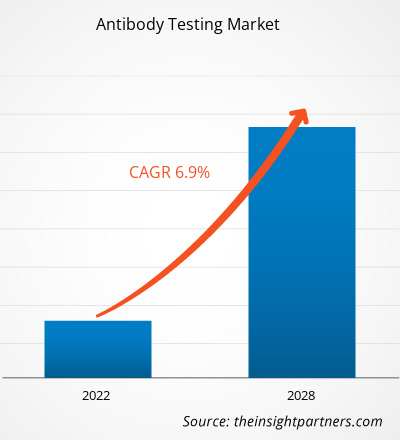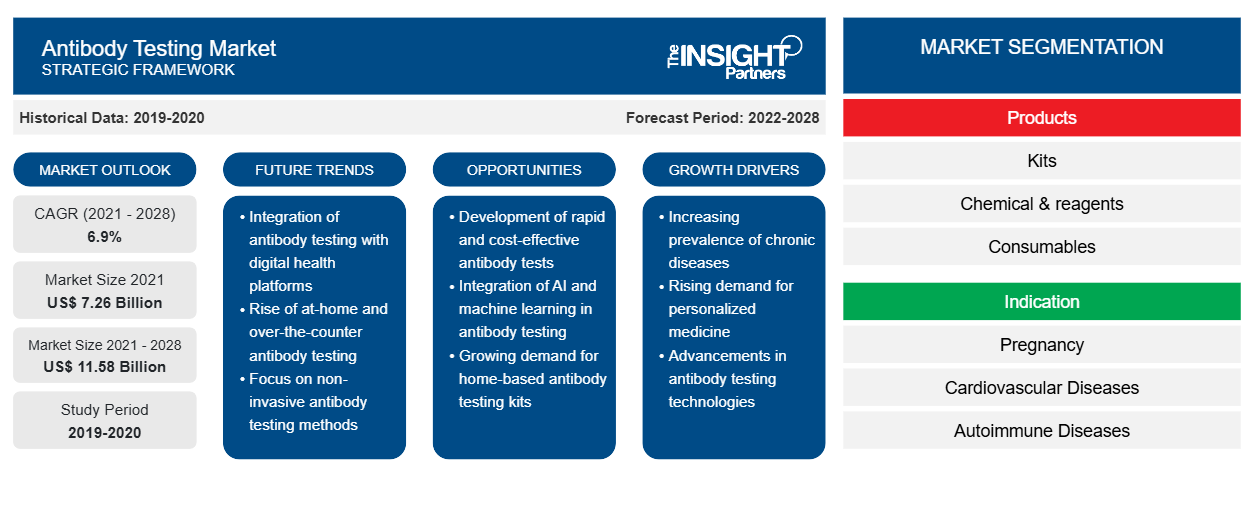Il mercato dei test sugli anticorpi è stato valutato a 7.260,00 milioni di dollari nel 2021 e si prevede che raggiungerà 11.578,47 milioni di dollari entro il 2028; si prevede una crescita a un CAGR del 6,9% dal 2021 al 2028.
Gli anticorpi sono immunoglobuline, proteine a forma di Y prodotte dal sistema immunitario per impedire agli invasori di danneggiare il corpo. Un test anticorpale è uno screening per gli anticorpi nel sangue. Il corpo produce anticorpi quando combatte infezioni come il COVID-19 o quando i pazienti vengono vaccinati. È così che si costruisce l'immunità contro un virus. Questi test sono anche chiamati test sierologici. I test anticorpali aiutano a diagnosticare una malattia autoimmune o ad escludere altre condizioni con segni e sintomi simili. Inoltre, gli anticorpi antinucleari (ANA) sono un gruppo di autoanticorpi prodotti dal sistema immunitario di un individuo quando non riesce a distinguere adeguatamente tra componenti "proprie" ed "estranee". Il test ANA rileva gli anticorpi nel sangue. Gli ANA reagiscono con parti di cellule sane del corpo e causano sintomi come infiammazione di tessuti e organi, dolori articolari e muscolari e affaticamento. Gli ANA prendono di mira specificamente le sostanze presenti nel nucleo cellulare; quindi gli anticorpi sono noti come "anticorpi antinucleari". I kit di rilevamento degli anticorpi sono predittivi della prognosi e del rilevamento dell'infezione da COVID-19 per supportare la malattia. Il mercato dei test sugli anticorpi è guidato da un numero crescente di casi di COVID-19 in tutto il mondo, da una prevalenza crescente di malattie croniche e da una popolazione anziana in crescita. Inoltre, il crescente supporto governativo sta alimentando la crescita dei test sugli anticorpi, che influenza lo sviluppo del mercato. Ad esempio, la Food and Drug Administration (FDA) degli Stati Uniti ha condiviso pubblicamente i dati sulle prestazioni dei test per i kit di test sugli anticorpi o sierologici. Questi risultati provengono da uno sforzo collaborativo di FDA, NIH, Centers for Disease Control and Prevention (CDC) e Biomedical Advanced Research and Development Authority (BARDA).
Personalizza questo report in base alle tue esigenze
Riceverai la personalizzazione gratuita di qualsiasi report, comprese parti di questo report, o analisi a livello nazionale, pacchetto dati Excel, oltre a usufruire di grandi offerte e sconti per start-up e università
-
Scopri le principali tendenze di mercato in questo rapporto.Questo campione GRATUITO includerà analisi di dati che spaziano dalle tendenze di mercato alle stime e alle previsioni.
L'ambito del mercato dei test sugli anticorpi include prodotti, indicazioni, utenti finali e geografia. Il mercato dei test sugli anticorpi viene analizzato in base a regioni quali Nord America, Europa, Asia Pacifico, Medio Oriente e Africa e Sud e Centro America. Il rapporto offre approfondimenti e analisi approfondite del mercato dei test sugli anticorpi, sottolineando vari parametri quali tendenze di mercato, progressi tecnologici, dinamiche di mercato e analisi del panorama competitivo dei principali attori del mercato in tutto il mondo.
Approfondimenti di mercato
Aumento del numero di casi di COVID-19 in tutto il mondo.
Da quando la sindrome respiratoria acuta grave coronavirus 2 (SARS-CoV-2) è stata dichiarata un'emergenza sanitaria pubblica di interesse internazionale alla fine di gennaio 2020, i professionisti medici e i ricercatori hanno sollecitato la necessità di test completi e rapidi sui cittadini per pianificare misure in grado di contenere la diffusione del virus. Nel tempo, i test di reazione a catena della polimerasi chain reaction in tempo reale e i test sugli anticorpi sono emersi come tecniche vitali per il sistema sanitario globale per gestire l'epidemia. Il rilevamento degli anticorpi è essenziale per la diagnosi differenziale di SARS-CoV-2. È un test eseguito su siero o plasma del paziente con globuli rossi reagenti. La determinazione di anticorpi specifici per patogeni e parassiti virali e batterici facilita l'adozione delle corrette misure terapeutiche. Il test sugli anticorpi è fondamentale per implementare una strategia di sanità pubblica efficace ed efficiente per ridurre al minimo l'impatto negativo della pandemia di COVID-19. Dovrebbe essere adottato per importanti casi di utilità clinica e supportare la strategia di ritorno al lavoro a livello globale.
I kit di rilevamento degli anticorpi sono predittivi per la prognosi e il rilevamento delle infezioni da COVID-19 per assistere le malattie. Poiché questi kit aiutano a esaminare se una persona ha sviluppato anticorpi nel flusso sanguigno per combattere il SARS-CoV-2, indicano se una persona è stata esposta o ha il COVID-19. Per gestire la pandemia di COVID-19 e aumentare lo screening dei pazienti, diverse aziende stanno offrendo questi kit di rilevamento rapido degli anticorpi a operatori sanitari, ospedali, laboratori e altri professionisti. Pertanto, l'aumento dell'incidenza dei casi di coronavirus e le crescenti approvazioni governative per i kit di test sugli anticorpi sono i pochi fattori responsabili della crescita del mercato.
Approfondimenti basati sui prodotti
Il mercato globale dei test sugli anticorpi, in base ai prodotti, è segmentato in kit, prodotti chimici e reagenti, materiali di consumo. Nel 2021, il segmento dei kit ha rappresentato la quota di mercato più elevata. La crescita di questo segmento è attribuita al gran numero di produttori come Abbott, F. Hoffmann-La Roche Ltd, Bio-Rad Laboratories, Inc. e altri e alla maggiore adozione di kit in vari processi di ricerca. È probabile che lo stesso segmento registri il CAGR più elevato nel mercato globale dei test sugli anticorpi durante il periodo di previsione. Inoltre, il segmento dei kit è suddiviso in kit per test sierologici, kit per immunoglobuline e kit per test a flusso laterale. I kit per test sierologici hanno detenuto la quota di mercato più elevata nel 2021.
Approfondimenti basati sulle indicazioni
Il mercato globale dei test sugli anticorpi, in base all'indicazione, è segmentato in gravidanza, malattie cardiovascolari, malattie autoimmuni, malattie infettive, oncologia, malattie endocrine e altri. Il segmento delle malattie infettive ha detenuto la quota maggiore del mercato nel 2021 e si prevede che lo stesso segmento registrerà il CAGR più elevato nel mercato durante il periodo di previsione.
Informazioni basate sull'utente finale
Il mercato globale dei test sugli anticorpi, in base all'utente finale, è suddiviso in ospedali, istituti accademici e di ricerca, laboratori diagnostici e aziende biofarmaceutiche. Il segmento dei laboratori diagnostici ha detenuto la quota maggiore del mercato nel 2021 e si prevede che lo stesso segmento registrerà il CAGR più elevato nel mercato durante il periodo di previsione.
La pandemia di COVID-19 era diventata la sfida più significativa in tutto il mondo. Questa sfida era spaventosa soprattutto nei paesi in via di sviluppo in tutto il mondo poiché ha portato alla riduzione delle importazioni a causa delle interruzioni nel commercio globale. Fino ad oggi non è stato stabilito alcun trattamento definitivo contro il COVID 19. Quindi, la mancanza di una terapia definitiva offre significative opportunità per il mercato dei test sugli anticorpi poiché la FDA statunitense aveva recentemente approvato l'uso della terapia al plasma per i pazienti COVID 19 gravemente malati. A lungo termine il mercato dei test sugli anticorpi avrebbe significative prospettive di crescita poiché molti operatori del mercato avevano ricevuto l'autorizzazione all'uso di emergenza per i loro nuovi test sugli anticorpi sviluppati. Tutti questi sviluppi si aggiungerebbero alla futura domanda per il mercato dei test sugli anticorpi.
I lanci di prodotti e le strategie di espansione sono comunemente adottati dalle aziende per espandere la propria presenza in tutto il mondo e soddisfare la crescente domanda. Queste strategie sono comunemente adottate dagli operatori di mercato per espandere il proprio portafoglio prodotti.
Gli operatori del mercato dei test sugli anticorpi hanno adottato la strategia dell'innovazione di prodotto per soddisfare la mutevole domanda dei clienti in tutto il mondo, il che consente loro anche di mantenere il proprio marchio a livello globale.
- A febbraio 2021, Agilent Technologies Inc. ha annunciato il lancio del kit Agilent Dako SARS-CoV-2 IgG Enzyme-Linked Immunosorbent Assay (ELISA) destinato al rilevamento qualitativo di anticorpi immunoglobulina G (IgG) per SARS-CoV-2 nel siero o plasma umano. Il kit, che segna l'ingresso di Agilent nei test SARS-CoV-2 negli Stati Uniti, ha completato il processo di notifica alla FDA in conformità con la Sezione IV.D della "Policy for Coronavirus Disease-2019 Tests During the Public Health Emergency (Revised)" della FDA. Il test avrebbe dovuto essere registrato in altri mercati nel 2021, tra cui Canada, Europa e alcuni paesi selezionati dell'Asia Pacifica e dell'America Latina.
- Ad aprile 2020, Abbott ha lanciato un test sierologico per rilevare l'anticorpo IgG al SARS CoV 2. Questo nuovo test anticorpale ha utilizzato gli strumenti di laboratorio ARCHITECT i1000SR e i2000SR di Abbott, che possono eseguire fino a 100-200 test all'ora.
Test sugli anticorpi – Segmentazione del mercato
Il mercato dei test sugli anticorpi è segmentato in base a prodotti, indicazioni e utente finale. In base ai prodotti, il mercato dei test sugli anticorpi è ulteriormente segmentato in kit, prodotti chimici e reagenti e materiali di consumo. In base all'indicazione, il mercato dei test sugli anticorpi è ulteriormente segmentato in gravidanza, malattie infettive, oncologia, malattie cardiovascolari, malattie endocrine, malattie autoimmuni e altre. In base all'utente finale, il mercato dei test sugli anticorpi è ulteriormente segmentato in ospedali, istituti accademici e di ricerca, laboratori diagnostici e aziende biofarmaceutiche. In base alla geografia, il mercato globale dei test sugli anticorpi è segmentato in Nord America (Stati Uniti, Canada e Messico), Europa (Francia, Germania, Regno Unito, Spagna, Italia, Grecia e resto d'Europa), Asia Pacifico (Cina, India, Giappone, Australia, Corea del Sud e resto dell'APAC), Medio Oriente e Africa (Arabia Saudita, Emirati Arabi Uniti, Sud Africa e resto del MEA) e Sud e Centro America (Brasile, Argentina e resto del SAM).
Approfondimenti regionali sul mercato dei test sugli anticorpi
Le tendenze regionali e i fattori che influenzano il mercato dei test sugli anticorpi durante il periodo di previsione sono stati ampiamente spiegati dagli analisti di Insight Partners. Questa sezione discute anche i segmenti e la geografia del mercato dei test sugli anticorpi in Nord America, Europa, Asia Pacifico, Medio Oriente e Africa e Sud e Centro America.

- Ottieni i dati specifici regionali per il mercato dei test sugli anticorpi
Ambito del rapporto di mercato sui test sugli anticorpi
| Attributo del report | Dettagli |
|---|---|
| Dimensioni del mercato nel 2021 | 7,26 miliardi di dollari USA |
| Dimensioni del mercato entro il 2028 | 11,58 miliardi di dollari USA |
| CAGR globale (2021 - 2028) | 6,9% |
| Dati storici | 2019-2020 |
| Periodo di previsione | 2022-2028 |
| Segmenti coperti |
Per prodotti
|
| Regioni e Paesi coperti |
America del Nord
|
| Leader di mercato e profili aziendali chiave |
|
Densità degli attori del mercato dei test sugli anticorpi: comprendere il suo impatto sulle dinamiche aziendali
Il mercato dei test sugli anticorpi sta crescendo rapidamente, spinto dalla crescente domanda degli utenti finali dovuta a fattori quali l'evoluzione delle preferenze dei consumatori, i progressi tecnologici e una maggiore consapevolezza dei benefici del prodotto. Con l'aumento della domanda, le aziende stanno ampliando le loro offerte, innovando per soddisfare le esigenze dei consumatori e capitalizzando sulle tendenze emergenti, il che alimenta ulteriormente la crescita del mercato.
La densità degli operatori di mercato si riferisce alla distribuzione di aziende o società che operano in un particolare mercato o settore. Indica quanti concorrenti (operatori di mercato) sono presenti in un dato spazio di mercato in relazione alle sue dimensioni o al valore di mercato totale.
Le principali aziende che operano nel mercato dei test sugli anticorpi sono:
- Termo Fisher Scientifico
- Laboratori Abbott
- Laboratori Bio-Rad, Inc.
- Beckton, Dickinson e compagnia
- F. Hoffmann La Roche
Disclaimer : le aziende elencate sopra non sono classificate secondo un ordine particolare.

- Ottieni una panoramica dei principali attori del mercato dei test sugli anticorpi
Profili aziendali
- Termo Fisher Scientifico
- Laboratori Abbott
- Laboratori Bio-Rad, Inc.
- Beckton, Dickinson e compagnia
- F. Hoffmann La Roche
- Tecnologie Agilent
- DiaSorina
- Zeus Scientific
- Abcam
- Trinità Biotech
- Analisi storica (2 anni), anno base, previsione (7 anni) con CAGR
- Analisi PEST e SWOT
- Valore/volume delle dimensioni del mercato - Globale, Regionale, Nazionale
- Industria e panorama competitivo
- Set di dati Excel
Report recenti
Rapporti correlati
Testimonianze
Motivo dell'acquisto
- Processo decisionale informato
- Comprensione delle dinamiche di mercato
- Analisi competitiva
- Analisi dei clienti
- Previsioni di mercato
- Mitigazione del rischio
- Pianificazione strategica
- Giustificazione degli investimenti
- Identificazione dei mercati emergenti
- Miglioramento delle strategie di marketing
- Aumento dell'efficienza operativa
- Allineamento alle tendenze normative























 Ottieni un campione gratuito per - Mercato dei test sugli anticorpi
Ottieni un campione gratuito per - Mercato dei test sugli anticorpi